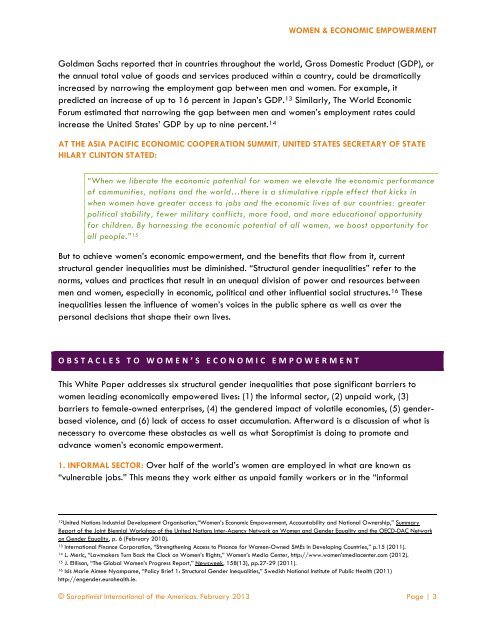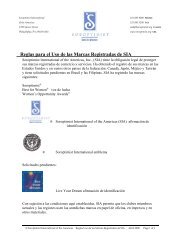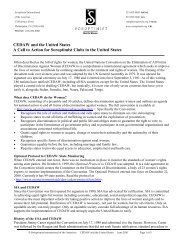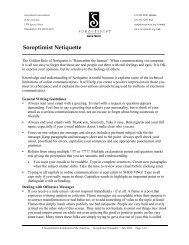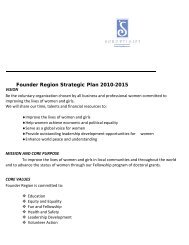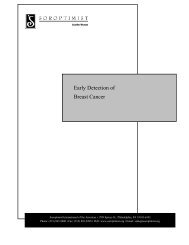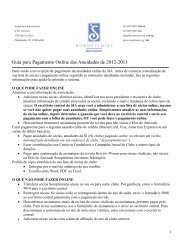Women and Economic Empowerment White Paper - Soroptimist
Women and Economic Empowerment White Paper - Soroptimist
Women and Economic Empowerment White Paper - Soroptimist
You also want an ePaper? Increase the reach of your titles
YUMPU automatically turns print PDFs into web optimized ePapers that Google loves.
WOMEN & ECONOMIC EMPOWERMENT<br />
Goldman Sachs reported that in countries throughout the world, Gross Domestic Product (GDP), or<br />
the annual total value of goods <strong>and</strong> services produced within a country, could be dramatically<br />
increased by narrowing the employment gap between men <strong>and</strong> women. For example, it<br />
predicted an increase of up to 16 percent in Japan’s GDP. 13 Similarly, The World <strong>Economic</strong><br />
Forum estimated that narrowing the gap between men <strong>and</strong> women’s employment rates could<br />
increase the United States’ GDP by up to nine percent. 14<br />
AT THE ASIA PACIFIC ECONOMIC COOPERATION SUMMIT, UNITED STATES SECRETARY OF STATE<br />
HILARY CLINTON STATED:<br />
“When we liberate the economic potential for women we elevate the economic performance<br />
of communities, nations <strong>and</strong> the world…there is a stimulative ripple effect that kicks in<br />
when women have greater access to jobs <strong>and</strong> the economic lives of our countries: greater<br />
political stability, fewer military conflicts, more food, <strong>and</strong> more educational opportunity<br />
for children. By harnessing the economic potential of all women, we boost opportunity for<br />
all people.” 15<br />
But to achieve women’s economic empowerment, <strong>and</strong> the benefits that flow from it, current<br />
structural gender inequalities must be diminished. “Structural gender inequalities” refer to the<br />
norms, values <strong>and</strong> practices that result in an unequal division of power <strong>and</strong> resources between<br />
men <strong>and</strong> women, especially in economic, political <strong>and</strong> other influential social structures. 16 These<br />
inequalities lessen the influence of women’s voices in the public sphere as well as over the<br />
personal decisions that shape their own lives.<br />
OBSTACLES TO WOMEN’S ECONOMIC EMPOWERMENT<br />
This <strong>White</strong> <strong>Paper</strong> addresses six structural gender inequalities that pose significant barriers to<br />
women leading economically empowered lives: (1) the informal sector, (2) unpaid work, (3)<br />
barriers to female-owned enterprises, (4) the gendered impact of volatile economies, (5) genderbased<br />
violence, <strong>and</strong> (6) lack of access to asset accumulation. Afterward is a discussion of what is<br />
necessary to overcome these obstacles as well as what <strong>Soroptimist</strong> is doing to promote <strong>and</strong><br />
advance women’s economic empowerment.<br />
1. INFORMAL SECTOR: Over half of the world’s women are employed in what are known as<br />
“vulnerable jobs.” This means they work either as unpaid family workers or in the “informal<br />
12<br />
United Nations Industrial Development Organisation,“<strong>Women</strong>’s <strong>Economic</strong> <strong>Empowerment</strong>, Accountability <strong>and</strong> National Ownership,” Summary<br />
Report of the Joint Biennial Workshop of the United Nations Inter-Agency Network on <strong>Women</strong> <strong>and</strong> Gender Equality <strong>and</strong> the OECD-DAC Network<br />
on Gender Equality, p. 6 (February 2010).<br />
13<br />
International Finance Corporation, “Strengthening Access to Finance for <strong>Women</strong>-Owned SMEs in Developing Countries,” p.15 (2011).<br />
14<br />
L. Meric, “Lawmakers Turn Back the Clock on <strong>Women</strong>’s Rights,” <strong>Women</strong>’s Media Center, http://www.women’smediacenter.com (2012).<br />
15<br />
J. Elllison, “The Global <strong>Women</strong>’s Progress Report,” Newsweek, 158(13), pp.27-29 (2011).<br />
16<br />
Isis Marie Aimee Nyampame, “Policy Brief 1: Structural Gender Inequalities,” Swedish National Institute of Public Health (2011)<br />
http://engender.eurohealth.ie.<br />
© <strong>Soroptimist</strong> International of the Americas. February 2013 Page | 3


